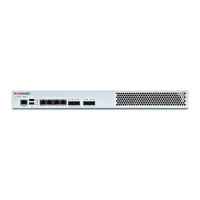IPSec IPSec set up
Make sure the NAT rule and Phase 2 Quick Mode selector are equal on Source, Destination and Service. For the
details of NAT, see "NAT".
Define IPSec parameters
Go to Service > IPSec
Add Phase 1 configurations for the IPSec tunnel mode VPN between site A's WAN 1 (10.10.10.10) and site B's WAN 1
(20.20.20.20). The other parameters are not listed here.
Phase 1 Local endpoint (Site A) Remote endpoint (Site B)
Name
WAN1_WAN1_Phase1 WAN1_WAN1_Phase1
Local IP
10.10.10.10 20.20.20.20
Remote IP
20.20.20.20 10.10.10.10
Add Phase 2 configurations for the IPSec tunnel mode VPN between site A 's WAN 1 (10.10.10.10) and site B's WAN 1
(20.20.20.20). The other parameters are not listed here.
Phase 2 Local endpoint (Site A) Remote endpoint (Site B)
Name
WAN1_WAN1_Phase2 WAN1_WAN1_Phase2
Quick Mode
Source
192.168.10.0/255.255.255.0 192.168.100.0/255.255.255.0
Source Port
Any Any
Destination
192.168.100.0/255.255.255.0 192.168.10.0/255.255.255.0
Destination Port
Any Any
Protocol
Any Any
For the details of IPSec configuration, see "IPSec VPN in the Web UI".
Procedures to set up a IPSec Tunnel-mode VPN
To set up a IPSec Tunnel-mode VPN, we suggest the steps to follow as below:
1.
Configure Network Settings on both units.
2.
Define correspondent Auto Routing and NAT policies on both units.
3.
Configure the settings of IPSec Tunnel mode Phase 1 and Phase 2 on both units.
202 FortiWAN Handbook
Fortinet Technologies Inc.

